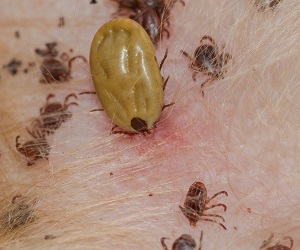If you notice your furry friend aggressively itching themselves, seeming to be in discomfort after returning home from their walk, then they may have some unwelcome guests, aka ticks! This ultimate guide will answer everything that you may be curious about and need to know about ticks.
Ticks and Diseases
These tiny blood-sucking bugs live in fields, wooded areas, or places visited by many furry friends, such as the dog park. They require human or animal blood for survival. Therefore, they are constantly on the hunt to find prey.
They are also known to transmit various diseases, some of which are:
- Lyme Disease
- Anaplasmosis
- Rocky Mountain Spotted Fever
- Babesiosis
- Tularemia
- Ehrlichiosis
- Tick-borne Relapsing Fever
A few symptoms may include chills, fever, headaches, body aches, nausea, and rashes. However, symptoms may vary depending on which disease it is. These symptoms may show up soon after getting bitten or even after years.
How Tick Infestations Start?
 A home infestation always begins with one tick making its way into your home by latching itself onto you or your dog's body.
A home infestation always begins with one tick making its way into your home by latching itself onto you or your dog's body.
As they are mainly found in dog parks, forests, wooden areas, etc., they often latch onto people or animals that frequently visit these areas.
You may have gone outdoors for a picnic or taken your dog for a walk and unknowingly brought home a blood-sucking bug that cunningly hid on your body.
A few places that they usually latch onto are:
- Behind your knees
- In your hair
- Inside your ear
- The groins
- Inside the belly button
- Under your arms
They even attach themselves to your furry friends and stay hidden under their thick fur. An infestation occurs after it reproduces and lays its eggs around your home. They often lay their eggs in furniture, curtains, rugs, windows, baseboards, and the door surroundings of your home.
Signs of an Infestation
The most common signs of an infestation are being bitten on your body or your dog or even finding live ticks on your dog or child's body.
 Since these bugs prefer moist and warm areas, they tend to target such areas on your body or your dog's body, and once they find that preferable spot, they will soon begin to bite and suck on the blood of their prey. While other insect bites are painful, the bite of a tick is painless.
Since these bugs prefer moist and warm areas, they tend to target such areas on your body or your dog's body, and once they find that preferable spot, they will soon begin to bite and suck on the blood of their prey. While other insect bites are painful, the bite of a tick is painless.
Another hint of an infestation is showing signs of a tick-borne disease that could either have a mild or severe effect. While these symptoms are often similar to other diseases, it could be challenging to identify if it is due to a tick infestation.
Often, rashes are the last to appear after all other signs, but as soon as that happens, it would be best to visit a doctor to prevent any complications in future with an early diagnosis.
Removal and Prevention
You can remove and prevent an infestation by following these steps:
- Vacuum your home regularly as that will capture any unattached. Dispose of the sealed dirt bag at an area far from your home
- Use insect repellents or fabrics with insect repellents when going outdoors
- Always inspect your pets, your kids, and yourself before you enter your home - after you have gone outdoors or visited an area that is known to be infested
- When going outdoors, ensure you wear full sleeves, long pants, socks, etc., to keep yourself covered
- If the infestation gets out of hand, use a pesticide or contact a local exterminator for a professional removal service
- Make your home and surrounding unsuitable or not preferable for ticks by grooming your vegetation and plants
- If you notice them on your pet, remove them with a tissue or pair of tweezers and kill them using alcohol, tape, or by flushing it. Ensure you book an appointment with your vet to treat the bites on your pet
- Keep your surrounding clean and free from pests such as rodents as they are known to carry ticks
When to Contact a Doctor?
If you get bitten and show symptoms of a tick-borne illness, then you should get yourself examined by a doctor as soon as possible. The soon you get examined and treated for the bite, the better it would be. Additionally, an easy diagnosis will help you take better steps to lessen the effect or treat the problem sooner.
A tick infestation may seem like no big deal besides seeing constant bite marks. However, it shouldn't be taken lightly. Tick prevention and removal are essential to keep your family, yourself, and pets free from ticks and tick-borne diseases.